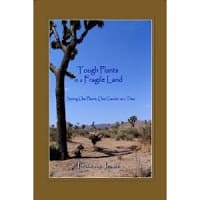Tough Plants in a Fragile land is an amazing look at the challenges and joy of desert gardening. From the fragrant Desert Lavender to the hearty Creosote Bush, Fritzie Von Jessen introduces beginning and avid gardeners to the beauty of desert gardening. And by using native plants and learning to garden in a chemical free and holistic manner, you can grow beautiful desert plants while still being gentle to our planet.
Table of Contents
Tough Plants in a Fragile Land
Posts feature partner companies & may be sponsored. Post contains affiliate links & I will be compensated if you make a purchase after clicking on links. As an Amazon Associate I earn from qualifying purchases.

Posts feature partner companies & may be sponsored. Post contains affiliate links & I will be compensated if you make a purchase after clicking on links. As an Amazon Associate I earn from qualifying purchases.
Love Desert Gardening?
Buy this book on Amazon!
- Title: Tough Plants in a Fragile Land (Amazon link)
- Subtitle: Saving our Planet, One Garden at a Time
- Author: Fritzie von Jessen
- ISBN: 978-0805978933
- Publisher: Dorrance Publishing Co.
- Pages: 166 (hardcover)
From the inside cover:
Do you think the only plants in the desert are cacti? You may be surprised! After a climate change devastated the nonnative plants in Fritzie von Jessen’s garden, she was inspired to research plants that thrive in the Colorado Desert.
From the fragrant Desert Lavender to the hearty Creosote Bush, Von Jessen introduces beginning and avid gardeners to the beauty of desert gardening. By using native plants and learning to garden in a chemical free and holistic manner, a gardener can contribute to the conservation and preservation of the environment. Von Jessen invites you to use her words as a guide”. Grab your shovel and imagination and dig in!
About Fritzie von Jessen :
A native of Denmark, Fritzie von Jessen currently lives and enjoys gardening in California’s Colorado Desert. She is a certified master desert gardener and desert naturalist.
Ms. von Jessen is currently a docent at the Living Desert in Palm Desert, California, and has also served as a docent at the Palm Springs Art Museum. When not involved with gardening, she enjoys skiing, photograph, and playing bridge.
Other Gardening Books You Might Enjoy
- Gardening for Geeks is the Perfect Gardening Book for Science Lovers
- The Weekend Homesteader
- The Secret Lives of Backyard Bugs
A tidbit of my life… Ladybird Johnson Wildflower Center
Many years ago, I took a day trip to Austin and visited the Ladybird Johnson Wildflower Center. They had a wonderful garden display that included two small plots of land, one right next to another.
One plot included traditional yard plantings. Things like grass, pansies, rose bushes and an assortment of other familiar ornamentals.
The other plot was filled with plants that were native to the Austin, Texas area. Neither one was watered or fertilized at all. The native garden was alive with thriving plants, bees, butterflies and beautiful flowers.
The desert is harsh and consequently, the traditional plants were dying. They had no beneficial insects in it at all. It was truly remarkable to see how much of a difference native plants make. Almost like they were made to grow in hot, dry climates!

✯Don’t want to miss the next post?✯
Follow Turning the Clock Back on Facebook | Twitter | Pinterest
Or join the private Facebook group for simple tips on going green!
My Review of Tough Plants in a Fragile land
Tough Plants in a Fragile land is a combination gardening book and photography journal about desert gardening. Every page has beautiful color photographs of plants and animals that are native to the Colorado Desert region.
It contains personal references scattered throughout the book. As a result, you get the sense that you are really learning about the author’s journey into native gardening. I was amused at the story of how she planted her agave plants too close to her front porch.
The sharp spines eventually prevented use of the front door until she had them professionally removed. As with most people, I assumed that desert meant sand, cacti, and the occasional scorpion. von Jessen shares a journey of exploration into the wide variety of plants and animals that thrive in that arid region.
Above all, this was a fabulous book! However, I wish there was a section of information about edible gardening. The author makes an occasional reference under each individual photo regarding its useful properties…edible parts, Native American medicines, etc.
I suggest dividing the book into chapters such as trees, flowers, bugs, edibles, etc. Dividing the book in this manner would make it a little easier to find information you might be interested in.
Most noteworthy about this book are the photos. The pictures are amazing and the information is written in such a way as to make it enjoyable to read, unlike some of the more ‘textbook’ type reference books I have looked at.
Will you be trying your hand at desert gardening this year?

Diane is a professional blogger and nationally certified pharmacy technician at Good Pill Pharmacy. She earned her BS in Microbiology at the University of New Hampshire and has worked in cancer research, academics, and biotechnology. Concern over the growing incidence of human disease and the birth of her children led her to begin living a more natural life. She quickly realized that the information she was learning along the way could be beneficial to many others and started blogging and freelance writing to share this knowledge with others. Learn more about her HERE.
